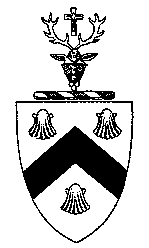This is a transcription of the Family Coat of Arms from History and Genealogy of the Ancestors and Some Descendants of Stukely Westcott by Roscoe L. Whitman, 1932, page 3.
The Family Coat of Arms
Those of the Westcott blood of today are entitled to use either one of two Coats of Arms registered to the early family in England. The Arms of Thomas Wescote, Esquire, ascribed to him in the year he was married to Elizabeth Littleton, about 1400, is reproduced on this page in outline. The one recorded to his son, Guedo Wescote, in 1450, is used, in correct colors, as the frontispiece of this book. There is still a third Coat of Arms, embracing a Moor’s head, which probably antedates those of Thomas and his son by several centuries. It appears to have been in disuse at least three generations before Thomas.
The Arms and Crest, attributed to Guedo Wescote, were intended evidently to take the place of all former Arms, for “the family seems to have been lost or was in the process of losing among the many Arms assumed by the marriage of Thomas Wescote, and the name was also being lost.”
The Guedo Arms—two hands issuing from clouds and conjoines in fesse, proper, and motto: Renovato nomine, meaning the name renewed—plainly suggests why the clasped hands issuing from clouds were used, and the appropriate motto. Based upon the ancient record of Guedo Wescote that from him “descended the Wescotes of Devon and Somerset,” the Arms attributed to him is accepted here as correct for the use of the family today.
The Arms of Thomas de Wescote: Argent, a chevron between three escallops, sable, with motto: Sic fidem teneo, meaning in this manner we keep faith; are of record quarterly-quartered, with (2) Littleton (his wife), (3) Wescote, (4) Quartermine, (5) Wescote, (6) Walter, (7) as (1) for Thomas. The Greek cross or patriarch, indicates the head of the family who rules by paternal right; argent or shield in silver or white, is emblematic of purity, innocence, etc.; chevron, divided as a shield into several parts, is representative of several families; the three escallops (three parts), “he quits his all; the pilgrim-staff he bore, and fix’d the scallop in his hat before.” It may be presumed that the Arms were registered to Thomas de Wescote in the third generation after heraldry became fixed by compulsory terms (end of 13th century).

